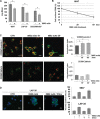CD99 triggering induces methuosis of Ewing sarcoma cells through IGF-1R/RAS/Rac1 signaling
- PMID: 27835596
- PMCID: PMC5346761
- DOI: 10.18632/oncotarget.13160
CD99 triggering induces methuosis of Ewing sarcoma cells through IGF-1R/RAS/Rac1 signaling
Abstract
CD99 is a cell surface molecule that has emerged as a novel target for Ewing sarcoma (EWS), an aggressive pediatric bone cancer. This report provides the first evidence of methuosis in EWS, a non-apoptotic form of cell death induced by an antibody directed against the CD99 molecule. Upon mAb triggering, CD99 induces an IGF-1R/RAS/Rac1 complex, which is internalized into RAB5-positive endocytic vacuoles. This complex is then dissociated, with the IGF-1R recycling to the cell membrane while CD99 and RAS/Rac1 are sorted into immature LAMP-1-positive vacuoles, whose excessive accumulation provokes methuosis. This process, which is not detected in CD99-expressing normal mesenchymal cells, is inhibited by disruption of the IGF-1R signaling, whereas enhanced by IGF-1 stimulation. Induction of IGF-1R/RAS/Rac1 was also observed in the EWS xenografts that respond to anti-CD99 mAb, further supporting the role of the IGF/RAS/Rac1 axis in the hyperstimulation of macropinocytosis and selective death of EWS cells. Thus, we describe a vulnerability of EWS cells, including those resistant to standard chemotherapy, to a treatment with anti-CD99 mAb, which requires IGF-1R/RAS signaling but bypasses the need for their direct targeting. Overall, we propose CD99 targeting as new opportunity to treat EWS patients resistant to canonical apoptosis-inducing agents.
Keywords: CD99; Ewing sarcoma; RAS; antibody; cell death.
Conflict of interest statement
The authors declare that they have no conflicts of interest.
Figures









Similar articles
-
CD99 triggering in Ewing sarcoma delivers a lethal signal through p53 pathway reactivation and cooperates with doxorubicin.Clin Cancer Res. 2015 Jan 1;21(1):146-56. doi: 10.1158/1078-0432.CCR-14-0492. Epub 2014 Dec 11. Clin Cancer Res. 2015. PMID: 25501132
-
CD99 at the crossroads of physiology and pathology.J Cell Commun Signal. 2018 Mar;12(1):55-68. doi: 10.1007/s12079-017-0445-z. Epub 2018 Jan 6. J Cell Commun Signal. 2018. PMID: 29305692 Free PMC article. Review.
-
Exosomes from CD99-deprived Ewing sarcoma cells reverse tumor malignancy by inhibiting cell migration and promoting neural differentiation.Cell Death Dis. 2019 Jun 17;10(7):471. doi: 10.1038/s41419-019-1675-1. Cell Death Dis. 2019. PMID: 31209202 Free PMC article.
-
CD99 polymorphisms significantly influence the probability to develop Ewing sarcoma in earlier age and patient disease progression.Oncotarget. 2016 Nov 22;7(47):77958-77967. doi: 10.18632/oncotarget.12862. Oncotarget. 2016. PMID: 27792997 Free PMC article.
-
Targeted therapies in Ewing's sarcoma.Adv Exp Med Biol. 2006;587:13-22. doi: 10.1007/978-1-4020-5133-3_2. Adv Exp Med Biol. 2006. PMID: 17163152 Review.
Cited by
-
Clinical and preclinical characterization of CD99 isoforms in acute myeloid leukemia.Haematologica. 2020 Apr;105(4):999-1012. doi: 10.3324/haematol.2018.207001. Epub 2019 Aug 1. Haematologica. 2020. PMID: 31371417 Free PMC article.
-
CD99-Derived Agonist Ligands Inhibit Fibronectin-Induced Activation of β1 Integrin through the Protein Kinase A/SHP2/Extracellular Signal-Regulated Kinase/PTPN12/Focal Adhesion Kinase Signaling Pathway.Mol Cell Biol. 2017 Jun 29;37(14):e00675-16. doi: 10.1128/MCB.00675-16. Print 2017 Jul 15. Mol Cell Biol. 2017. PMID: 28483911 Free PMC article.
-
Insulin-Like Growth Factor 2 mRNA-Binding Protein 3 Modulates Aggressiveness of Ewing Sarcoma by Regulating the CD164-CXCR4 Axis.Front Oncol. 2020 Jul 3;10:994. doi: 10.3389/fonc.2020.00994. eCollection 2020. Front Oncol. 2020. PMID: 32719743 Free PMC article.
-
Anti-c-MET Fab-Grb2-Gab1 Fusion Protein-Mediated Interference of c-MET Signaling Pathway Induces Methuosis in Tumor Cells.Int J Mol Sci. 2022 Oct 10;23(19):12018. doi: 10.3390/ijms231912018. Int J Mol Sci. 2022. PMID: 36233320 Free PMC article.
-
Methuosis Contributes to Jaspine-B-Induced Cell Death.Int J Mol Sci. 2022 Jun 29;23(13):7257. doi: 10.3390/ijms23137257. Int J Mol Sci. 2022. PMID: 35806262 Free PMC article.
References
-
- Crompton BD, Stewart C, Taylor-Weiner A, Alexe G, Kurek KC, Calicchio ML, Kiezun A, Carter SL, Shukla SA, Mehta SS, Thorner AR, de Torres C, Lavarino C, Sunol M, McKenna A, Sivachenko A, et al. The genomic landscape of pediatric Ewing sarcoma. Cancer Discov. 2014;4:1326–1341. - PubMed
-
- Tirode F, Surdez D, Ma X, Parker M, Le Deley MC, Bahrami A, Zhang Z, Lapouble E, Grossetete-Lalami S, Rusch M, Reynaud S, Rio-Frio T, Hedlund E, Wu G, Chen X, Pierron G, et al. Genomic landscape of Ewing sarcoma defines an aggressive subtype with co-association of STAG2 and TP53 mutations. Cancer Discov. 2014;4:1342–1353. - PMC - PubMed
-
- Delattre O, Zucman J, Plougastel B, Desmaze C, Melot T, Peter M, Kovar H, Joubert I, de Jong P, Rouleau G, et al. Gene fusion with an ETS DNA-binding domain caused by chromosome translocation in human tumours. Nature. 1992;359:162–165. - PubMed
-
- Kovar H. Blocking the road, stopping the engine or killing the driver? Advances in targeting EWS/FLI-1 fusion in Ewing sarcoma as novel therapy. Expert Opin Ther Targets. 2014;18:1315–1328. - PubMed
MeSH terms
Substances
Grants and funding
LinkOut - more resources
Full Text Sources
Other Literature Sources
Medical
Molecular Biology Databases
Research Materials
Miscellaneous

